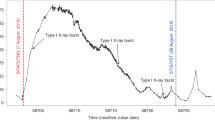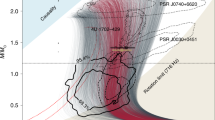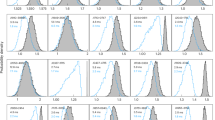Abstract
THE interpretation of 1,968.629-Hz optical pulsations1 from supernova 1987A as a rapidly rotating neutron star poses a chal-lenge to models of nuclear matter. The simultaneous requirement that a star with angular velocity ω SN = 1.237 x 104 s-1 be stable against non-axisymmetric perturbations and that the maximum mass of a non-rotating neutron star exceed 1.44 Ṁ (the mass of the binary pulsar) seems to rule out all standard equations of state2,3. Three-flavour (up, down, and strange) quark matter, or 'strange matter', may be absolutely stable4,5, that is, it may com-prise the ground state of the hadrons. Neutron stars may become strange stars6–8, which have a different equation of state and mass-radius relation from conventional neutron-star models. For a range of hadron parameters, the maximum rotation rate of secularly stable strange stars may exceed that of the half-millisecond pulsar and the non-rotating maximum mass Mmax is greater than 1.52 Ṁ. The low-mass companion(s) to SN1987A, inferred from the periodic modulations of the optical signal, can be accounted for by stable strange-matter lump(s) ejected from the young strange star.
This is a preview of subscription content, access via your institution
Access options
Subscribe to this journal
Receive 51 print issues and online access
$199.00 per year
only $3.90 per issue
Buy this article
- Purchase on SpringerLink
- Instant access to full article PDF
Prices may be subject to local taxes which are calculated during checkout
Similar content being viewed by others
References
Kristian, J. et al. Nature 338, 234–236 (1989).
Friedman, J. L., Ipser, J. & Parker, L. Astrophys. J. 304, 115–139 (1986).
Friedman, J. L., Ipser, J. & Parker, L. Phys. Rev. Lett. 62, 3015–3019 (1989).
Farhi, E. & Jaffe, R. L. Phys. Rev. D 30, 2379–2390 (1984).
Witten, E. Phys. Rev. D 30, 272–285 (1984).
Alcock, C., Farhi, E. & Olinto, A. V. Astrophys. J. 310, 261–272 (1986).
Olinto, A. V. Phys. Lett. B 192, 71–75 (1987).
Haensel, P., Zdunik, J. & Schaeffer, R. Astr. Astrophys. 160, 121–128 (1986).
Weisberg, J. & Taylor, J. Phys. Rev. Lett. 52, 1348–1351 (1984).
Arnett, W. D. & Bowers, R. L. Astrophys. J. Suppl. 33, 415–436 (1977).
Pandharipande, V. Nucl. Phys. A174, 641–656 (1971).
Chandrasekhar, S. Ellipsoidal Figures of Equilibrium (Yale University Press, 1969).
Chandrasekhar, S. Astrophys. J. 161, 561–569 (1970).
Butterworth, E. & Ipser, J. Astrophys. J. 204, 200–223 (1976).
Friedman, J. L. Phys. Rev. Lett. 51, 11–14 (1983).
Lindblom, L. Astrophys. J. 303, 146–153 (1986).
Cutler, C. & Lindblom, L. Astrophys. J. 314, 234–241 (1987).
Imamura, J., Friedman, J. L. & Durisen, R. Astrophys. J. 294, 474–478 (1985).
Managan, R. Astrophys. J. 294, 463–473 (1985).
Haensel, P. & Jerzak, A. Acta Phys. Pol. B 20, 141–161 (1989).
Flowers, E. & Itoh, N. Astrophys. J. 230, 847–858 (1979).
Alcock, C. & Olinto, A. A. Rev. Nucl. Particle Sci. 38, 161–184 (1988).
Ipser, J. & Lindblom, L. Phys. Rev. Lett. 62, 2777–2780 (1989).
Sawyer, R. Phys. Rev. D 39, 3804–3806 (1989).
Author information
Authors and Affiliations
Rights and permissions
About this article
Cite this article
Frieman, J., Olinto, A. Is the sub-millisecond pulsar strange?. Nature 341, 633–635 (1989). https://doi.org/10.1038/341633a0
Received:
Accepted:
Issue date:
DOI: https://doi.org/10.1038/341633a0
This article is cited by
-
Modeling of compact stars: an anisotropic approach
General Relativity and Gravitation (2021)
-
Isotropic uncharged model with compactness and stable configurations
Arabian Journal of Mathematics (2021)
-
Effect of pressure anisotropy on Buchdahl-type relativistic compact stars
General Relativity and Gravitation (2019)
-
Six flavor quark matter
Journal of High Energy Physics (2018)



